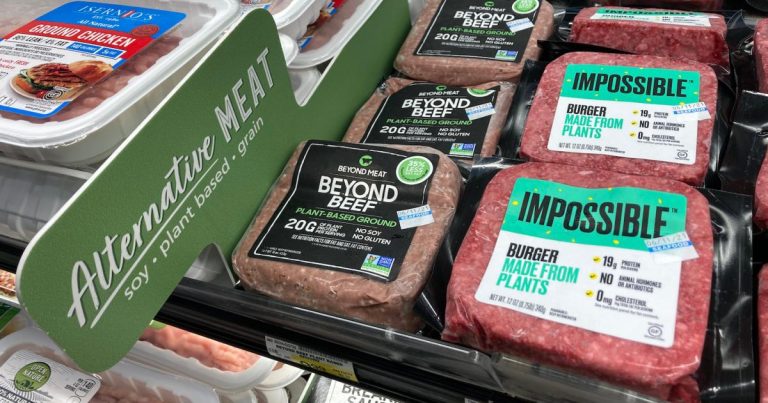The alternative protein industry is currently in a tough spot. Brands big and small have been pulling unsuccessful products off the shelves, raising financing rounds with rather unfavorable terms or closing shop altogether. A venture capitalist with a significant alternative protein portfolio recently told me he expects most of his portfolio companies in this space to go out of business before the end of the year.
This is rather demoralizing news for many who see meat, egg and dairy alternatives as an essential way out of the ecological and ethical conundrum animal agriculture poses — myself included. But the future may not look as gloomy as it feels today, according to Rachel Konrad, chief brand officer of the venture capital firm Production Board and former Impossible Foods and Tesla executive.
Let’s explore what keeps Konrad’s hopes up and check out her advice for struggling entrepreneurs.
Leaning into Tesla’s success story
Konrad likes to draw on the Gartner hype cycle concept to unpack innovation trends. This imperfect but popular theory helps explain technology development, deployment and adoption.

Its five stages go as follows:
-
Technology trigger: New tech development kicks off; media start covering it, but viable products don’t exist yet.
-
Peak of inflated expectations: Early success stories alongside investor and media hype create unrealistic predictions for the technology while companies are still honing the product.
-
Trough of disillusionment: Due to a problem in the industry, such as failing experiments or unfavorable macroeconomic conditions, it falls into a steep decline and appears to fail altogether. Many companies go out of business; others rush to improve their products.
-
Slope of enlightenment: Technology matures, price drops and a broader understanding of the innovation’s benefits leads to renewed consumer interest.
-
Plateau of productivity: Mainstream adoption starts to happen as the technology’s promise and relevance materialize. It eventually becomes the dominant technology.
Konrad has seen electric vehicles go through this cycle in her work at Tesla and other automotive companies. “Back in 2008, when gasoline prices were up, and electric batteries had their aha moment, people were saying that by 2015, 50 percent of all cars will be electric,” Konrad said. “But that didn’t happen. Things collapsed, people stopped investing in the sector and Tesla’s stock was in the toilet.” She thinks the company mainly survived due to a $465 million loan from the federal government in 2009.
Tesla — and the electric car industry more broadly — eventually made it through the trough of disillusionment and is finally seeing mainstream adoption rates.
In Q1 2023, Tesla’s Model Y became the world’s first electric vehicle to top a quarter’s best-selling car list. In Norway, 80 percent of new-car sales were electric in 2022 and the country will end sales of internal combustion engine cars in 2025.
I’m 100 percent convinced that alternative proteins will almost completely replace animal agriculture, but it takes time, and you have to work through the hype cycle.
That sounds pretty mainstream to me — but getting there took 10 years longer than expected.
Konrad recognizes many of the same patterns in the alternative protein industry and believes in a similar result for the sector. “I’m 100 percent convinced that alternative proteins will almost completely replace animal agriculture, but it takes time, and you have to work through the hype cycle.”
Wading through the trough of disillusionment
Konrad estimates that the alternative protein industry is now at or near the bottom of the curve and that it may take about two years to work through this phase. The primary adoption roadblock is its inability to compete over price with low-cost animal products such as ground beef and chicken.
Food entrepreneurs will need to find ways to drive down costs consistently to come out of the downturn. But that’s not a given when raising money for the science and manufacturing improvements that could unlock cost savings is becoming more challenging.
As a result, startups will have to become more creative when it comes to their funding sources. Some may pursue Tesla’s route and apply for low-interest government loans when available, while others might look for grants, academic research funding or establish closer partnerships with large food companies.
Startups will also have to be much more conservative with their expenses until sales pick up again. “It’s a brutal time, and they really just need to grid it out, preserving their cash runway under all circumstances,” Konrad told me. “That often means undergoing either a gigantic workforce reduction or doing something drastic like cutting everyone’s salaries by 25 to 40 percent. I’ve seen both things happening — it’s painful, but the right thing to do.”
I feel for all the mission-driven founders and their teams and hope most will come out stronger — with cheaper and tastier products — on the other side. That will be for the benefit of all of us. Recent research showed that a dietary shift away from animal-sourced foods around the world could save up to $7.3 trillion per year in human health and ecosystem damages, which animal agriculture currently causes.

